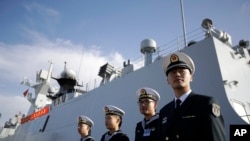China's growing use of advanced technology in a disputed Asian sea may be meant more to inspire its citizens and get respect from abroad than to double down on disputed sovereignty claims as feared by other countries, scholars and Chinese media reports say.
Maritime scholars believe these scientific advances will hand information to the Chinese People’s Liberation Army, bolstering control over its claims over about 90 percent of the 3.5 square-million-kilometer South China Sea. But China is also looking to show citizens it can make achievements, some believe.
It may also be trying to impress other countries after a sting from the world court last year.
“We shouldn't forget that tucked away there are these marine scientists, who they may not have control of policy, but they're scientists like anyone else,” said Euan Graham, international security director with the Lowy Institute for International Policy in Sydney. “We shouldn't tar them as being foot soldiers or proxies.”
When China announced last month it had finished five years of testing its Jiaolong bathyscaphe – an undersea observation vehicle -- with plans for a wide-reaching probe in 2020, the Chinese Academy of Sciences predicted the mission would “earn the nation a bigger say” in deep-sea resource exploration.
The academy quoted a government official in May calling Beijing’s discovery of “combustible ice” natural gas hydrate in the South China Sea a “major breakthrough that may lead to a global energy revolution.”
And when Chinese scientists said in February their country would build its first underwater observation platform, the state-controlled Global Times news website quoted one saying the plan “showcases that the country is actively joining in the international competition.” The platform could be positioned in the South China Sea or East China Sea.
These cases suggest a Chinese effort to stoke domestic confidence in the Communist leadership to bring home resources through technology, scholars say. Even China’s military and space hardware is described domestically as technological rather than military advances.
“Jiaolong and (the aircraft carrier) Liaoning, those are the pilot programs that China would put on stamp collections specifically for the National People’s Congress,” said Alexander Huang, strategic studies professor at Tamkang University in Taiwan, referring to the Chinese parliament.
Chinese officials hope to show citizens they can secure resources for a 1.37 billion population and an industrial economy forecast to grow 6.7 percent this year, analysts say. They need cleaner-burning fuel to offset the pollution from coal burning, Graham said. Undersea probes may turn up oil and minerals including rare ones, Huang added.
“There is a competition for rare earths that are mostly preserved in the seabed, so Jiaolong can detect some useful resources, not necessarily for military operations but for industries and new technologies,” Huang said.
Deep-sea vehicles such as the Jiaolong bathyscaphe “offer new hopes of setting up deep-sea labs, where scientists can conduct biological, medical and genetic research and explore mineral, oil and gas resources,” the official Xinhua News Agency said in March.
China is trying to improve its reputation abroad, as well, by emphasizing the science angle of undersea activities after a world arbitration court tribunal ruled in July 2016 that China lacked a legal basis for its sovereignty claims to the sea, analysts believe.
The tribunal said in its ruling it found “no doubt that China’s artificial island-building activities on the seven reefs in the Spratly Islands have caused devastating and long-lasting damage to the marine environment.”
The Spratlys are the most heavily contested chain in the sea. Brunei, Malaysia, Taiwan, Vietnam and the Philippines claim tracts that overlap China’s. Other countries resent the Chinese artificial buildup of islands in waters they call their own, usually based on exclusive economic zones 370 kilometers off their coasts.
That ruling contained “very pointed” language about Beijing’s environmental damage, Graham said, so China may now be on “a positive PR offensive.”
On that note, a city in China quickly declared off limits last year a geologically rare, 301-meter-deep (987-foot) ocean sinkhole inside one of the sea’s Paracel Islands, which Vietnam also claims. The city said it would preserve rather than develop land around the hole.
But efforts to stoke public pride and overseas confidence would not preclude a military link to new marine technology, said Jay Batoncbacal, director of the Institute for Maritime Affairs and Law of the Sea at the University of the Philippines in Metro Manila. Technology, he said, can help a country “maintain, gain and exclude access” by staying ahead of rival inventions.
“China’s technology and available resources and available manpower, it’s just way too much," he said. "For even all of them (other claimants) combined, they simply cannot match it.”
China has a record of using energy exploration projects “as a tool to stake a claim” in the South China Sea, American geopolitical intelligence platform Stratfor said in a 2012 commentary. “Indeed, deep-sea mining exploration could spread China's influence in the South China Sea, the East China Sea and the Indian Ocean,” it said.






